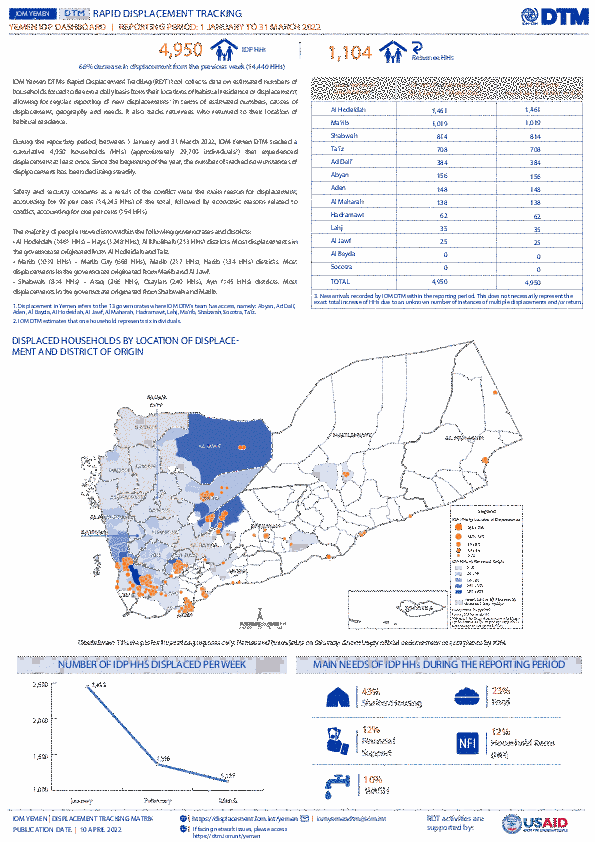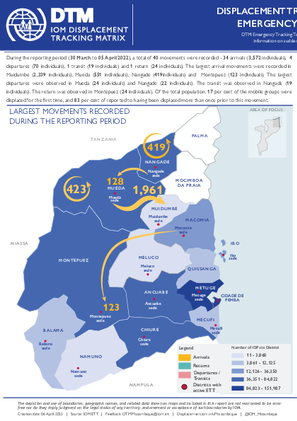-
Countries
-
Data and Analysis
-
Special Focus
-
Crisis Responses

Contact
DTM Yemen, iomyemendtm@iom.int
Language
English
Location
Yemen
Period Covered
Jan 01 2022
Mar 31 2022
Activity
- Rapid Emergency Registration
- Mobility Tracking
IOM Yemen DTM’s Rapid Displacement Tracking (RDT) tool collects data on estimated numbers of
households forced to flee on a daily basis from their locations of habitual residence or displacement,
allowing for regular reporting of new displacements1 in terms of estimated numbers, causes of
displacement, geography and needs. It also tracks returnees who returned to their location of
habitual residence.
During the reporting period, between 1 January and 31 March 2022, IOM Yemen DTM tracked a
cumulative 4,950 households (HHs) (approximately 29,700 individuals2) that experienced
displacement at least once. Since the beginning of the year, the number of tracked new instances of
displacement has been declining steadily.
Safety and security concerns as a result of the conflict were the main reason for displacement,
accounting for 99 per cent (14,245 HHs) of the total, followed by economic reasons related to
conflict, accounting for one per cent (194 HHs).
The majority of people moved into/within the following governorates and districts:
- Al Hodeidah (1461 HHs) – Hays (1248 HHs), Al Khukhah (213 HHs) districts. Most displacements in the governorate originated from Al Hodeidah and Taiz.
- Marib (1019 HHs) – Marib City (668 HHs), Marib (217 HHs), Harib (134 HHs) districts. Most displacements in the governorate originated from Marib and Al Jawf.
- Shabwah (814 HHs) – Ataq (266 HHs), Osaylan (240 HHs), Ayn (145 HHs) districts. Most displacements in the governorate originated from Shabwah and Marib.

Contact
DTM Nigeria, AllUsersInDTMNigeria@iom.int
Language
English
Location
Nigeria
Period Covered
Apr 02 2022
Apr 08 2022
Activity
- Mobility Tracking
- Baseline Assessment
- Points of Entry (PoE)
During the COVID-19 pandemic, IOM's Displacement Tracking Matrix (DTM), in collaboration with the World Health Organization (WHO), monitors cross-border movements to and from Nigeria's Borno State in north-east Nigeria. Assessments are conducted at Points of Entry located along the border with Cameroon.
A range of data was collected during the assessments to better inform on travellers’ nationalities, sex, reasons for moving, mode of transportation and timeline of movement as shown in figures 2 to 5 below.

Contact
DTM Nigeria, AllUsersInDTMNigeria@iom.int
Language
English
Location
Nigeria
Period Covered
Apr 04 2022
Apr 10 2022
Activity
- Event Tracking
- Mobility Tracking
Nigeria's north-central and north-west zones are afflicted with a multidimensional crisis rooted in long-standing tensions between ethnic and religious groups and involves attacks by criminal groups and banditry/hirabah (such as kidnapping and grand larceny along major highways). During the past years, the crisis has accelerated because of the intensification of attacks and has resulted in widespread displacement across the region.
Between the 04th and 10th of April 2022, armed clashes and banditry have led to new waves of population displacement. Following these events, rapid assessments were conducted by DTM (Displacement Tracking Matrix) field staff to inform the humanitarian community and government partners, and enable targeted response. Flash reports utilise direct observation and a broad network of key informants to gather representative data and collect information on the number, profile and immediate needs of affected populations.
During the assessment period, the DTM identified an estimated 1,507 individuals who were affected by the attacks. A total of 1,478 individuals were displaced to neighbouring wards in the LGAs Wurna in Sokoto State and Kajuru in Kaduna State, while 20 individuals affected in Rafin Iwa ward in LGA Sabuwa in Katsina State are still within the attacked ward. A total of 22 casualties
were reported, including 13 injuries and 9 fatalities.

Contact
DTM South Sudan, SouthSudanDTM@iom.int
Language
English
Location
South Sudan
Period Covered
Mar 02 2022
Mar 04 2022
Activity
- Site Assessment
- Registration
- Flow Monitoring
- Mobility Tracking
In March 2022, the population of the Bentiu town sites was counted at 52,257 individuals (8,662 households), representing a 131.79 per cent increase relative to December 2021 (22,545 individuals). Major population increases are observed across all sites.

Contact
DTMMozambique@iom.int
Language
English
Location
Mozambique
Period Covered
Mar 30 2022
Apr 05 2022
Activity
- Event Tracking
- Mobility Tracking
During the reporting period (30 March to 05 April 2022), a total of 40 movements were recorded - 34 arrivals (3,572 individuals), 4 departures (70 individuals), 1 transit (19 individuals) and 1 return (24 individuals). The largest arrival movements were recorded in Muidumbe (2,339 individuals), Mueda (551 individuals), Nangade (419individuals) and Montepuez (123 individuals). The largest departures were observed in Mueda (24 individuals) and Nangade (22 individuals). The transit was observed in Nangade (19 individuals). The return was observed in Montepuez (24 individuals). Of the total population, 17 per cent of the mobile groups were displaced for the first time, and 83 per cent of reported to having been displaced more than once prior to this movement.

Contact
DTM Europe, DTMMediterranean@iom.int
Language
English
Location
Republic of Moldova
Period Covered
Feb 24 2022
Apr 12 2022
Activity
- Flow Monitoring
- Migrants presence
To date, Ukrainian refugees represent 91 per cent (377,272) of all individuals registered at entry from Ukraine to the Republic of Moldova, while the remaining 9 per cent (36,153) are Third-Country Nationals (TCNs).
Similarly, Ukrainian refugees represent 89 per cent (284,361) of all individuals, among those entered the Republic of Moldova since 24 February 2022, to have left the country by flight, towards Romania or towards Ukraine, while the remaining 11 per cent (32,403) are TCNs.
This report focuses on trends of TCNs from Ukraine to the Republic of Moldova, analyzing data on their stay or subsequent onward movement out of the country.

Contact
DTM Mali, DTMMali@iom.int
Language
French
Location
Mali
Period Covered
Feb 01 2022
Feb 28 2022
Activity
- Mobility Tracking
- Baseline Assessment
De janvier à septembre 2021, dans un contexte marqué par l’insécurité et la pandémie à coronavirus, les groupes armés ont poursuivi leurs attaques contre les populations civiles dans le Nord et le Centre du pays. Dans le Centre, des violences intercommunautaires et des affrontements ont été signalés. Le caractère violent des conflits a provoqué d’importants déplacements de populations tant à l’intérieur du territoire malien que vers les pays limitrophes.
Chaque semaine, de nouvelles personnes déplacées internes (PDI) continuent d’être enregistrées. Ces mouvements ont un impact considérable sur les personnes forcées de fuir leurs foyers et sur les communautés qui les accueillent.
Afin de répondre aux besoins des populations déplacées internes, rapatriées et retournées, la Commission Mouvement de Populations (CMP) recueille et analyse les informations sur les mouvements de populations à l’intérieur du Mali, afin de fournir un état complet des mouvements de populations et à la demande de ses partenaires. Les membres de la Commission sont : la Direction Générale de la Protection Civile (Ministère de la sécurité intérieur), UNHCR, OCHA, PAM, UNICEF, ACTED, NRC, DRC, HI, Solidarités International, CRS, OIM, et DNDS. Plusieurs autres entités participent régulièrement aux rencontres de la Commission.

Contact
DTM Mali, DTMMali@iom.int
Language
French
Location
Mali
Period Covered
Jan 01 2022
Jan 31 2022
Activity
- Mobility Tracking
- Baseline Assessment
De janvier à septembre 2021, dans un contexte marqué par l’insécurité et la pandémie à coronavirus, les groupes armés ont poursuivi leurs attaques contre les populations civiles dans le Nord et le Centre du pays. Dans le Centre, des violences intercommunautaires et des affrontements ont été signalés. Le caractère violent des conflits a provoqué d’importants déplacements de populations tant à l’intérieur du territoire malien que vers les pays limitrophes.
Chaque semaine, de nouvelles personnes déplacées internes (PDI) continuent d’être enregistrées. Ces mouvements ont un impact considérable sur les personnes forcées de fuir leurs foyers et sur les communautés qui les accueillent.
Afin de répondre aux besoins des populations déplacées internes, rapatriées et retournées, la Commission Mouvement de Populations (CMP) recueille et analyse les informations sur les mouvements de populations à l’intérieur du Mali, afin de fournir un état complet des mouvements de populations et à la demande de ses partenaires. Les membres de la Commission sont : la Direction Générale de la Protection Civile (Ministère de la sécurité intérieur), UNHCR, OCHA, PAM, UNICEF, ACTED, NRC, DRC, HI, Solidarités International, CRS, OIM, et DNDS. Plusieurs autres entités participent régulièrement aux rencontres de la Commission.

